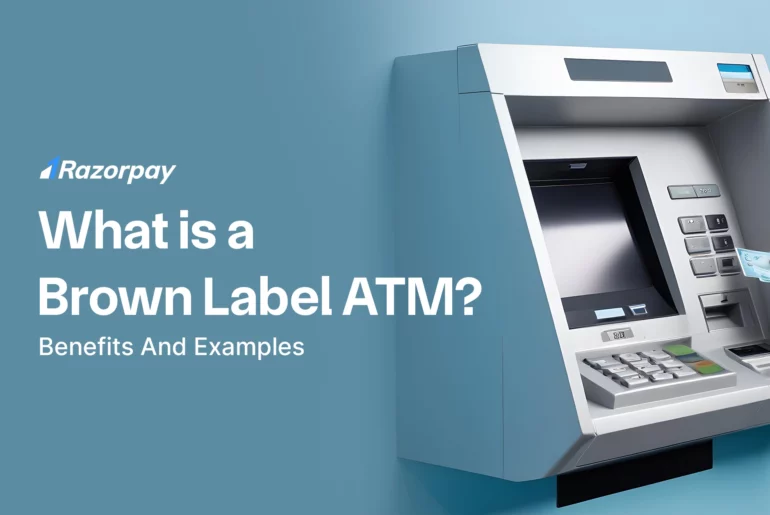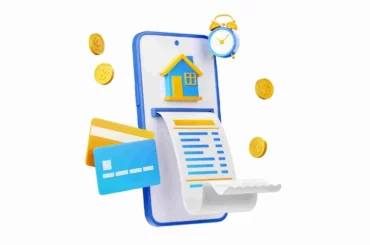Brown Label ATMs are operated by service providers who lease the ATM hardware, with cash management and connectivity to banking networks handled by a sponsor bank. This model serves as a hybrid between bank-owned and White Label ATMs. Its advantages include improving financial inclusion by offering convenient access to banking services without requiring visits to branches.
This article examines Brown Label ATMs, discussing both their benefits and limitations.
Related Read: What are the Advantages And Disadvantages of ATM
Table of Contents
What is a Brown Label ATM?
Brown label ATMs are a type of Automated Teller Machine where a service provider manages the hardware and leasing, while cash management and network connectivity are overseen by a sponsor bank whose branding appears on the ATM.
The service provider maintains and operates the ATM, while the sponsor bank handles cash logistics and connectivity to banking networks. Typically branded with the sponsor bank’s logo, these ATMs enable banks to expand their ATM networks efficiently without direct infrastructure investments.
Brown Label ATM Example
An example of a brown label ATM setup is when Bank A partners with a service provider, Company B, to oversee the management and operation of ATMs in rural and semi-urban regions. Company B assumes responsibility for leasing the ATM hardware and maintaining it, while Bank A’s branding is visibly featured on the ATMs. This collaboration allows Bank A to extend its ATM network reach without bearing the full infrastructure costs, leveraging Company B’s expertise in ATM operations and maintenance.
Benefits of Brown Label ATMs
- Capital Expenditure Relief: Banks benefit under the BLA model by avoiding upfront investments in ATM hardware and maintenance, which are managed by the service provider.
- Cost Efficiency: For smaller banks with limited national reach, it becomes more economical to pay transaction fees to service providers rather than purchasing and maintaining their ATMs.
- Incentive for Efficiency: The fee structure based on transactions encourages efficient use of ATMs, ensuring optimal deployment and operation across various locations.
- Enhanced Accessibility: This approach enables banks to strategically expand ATM services into rural, semi-urban, and underserved areas, promoting financial inclusion without extensive branch infrastructure investments.
- Operational Advantage: Banks can focus on core banking functions while leveraging the service provider’s expertise in ATM management and operational support.
Brown Label ATM Operators in India in 2025
| FIS (Fidelity Information Services) |
| TSI (Transaction Solutions International) |
| TCBIL (Tata Communications Payment Solutions Limited) |
| Diebold |
| AGS (Automated Global Services) |
| Prizm |
| FSS (Financial Software and Systems) |
| Euronet |
Cost Sharing in Brown Label ATMs
In the case of a BLA, the ATM operator shoulders the initial financial burden, acting as the upfront investor. Banks then compensate them through a transaction-based system or a fixed monthly payment. This reimbursement covers the essential services provided by the operator, which include managing the ATM’s cash supply, overseeing its network connection, ensuring its security, and handling any necessary maintenance.
Here are key insights from the “India ATM Market Outlook to 2026” report by Ken Research, published in August 2021, to provide clarity:
| Parameter | INR |
| Cost per transaction | 7.7 |
| Revenue per transaction | 11.0 |
| Profit per transaction | 3.3 |
| Number of transactions for break-even per day | 70 |
| Coverage of investment after years | 3.8 |
What is the Difference Between a Brown Label ATM and a White Label ATM?
| Brown Label ATM | White Label ATM |
| Operated by outsourcing firms under contracts with specific banks | Owned and operated by non-banking entities |
| Displays the logo or name of the sponsoring bank on the machines | Does not display any bank logos or branding on the machines |
| The hardware and machines are leased by service providers | Require licenses and permissions from the RBI to operate |
| The RBI is not directly involved in the regulation of these ATMs, as they operate under bank contracts | RBI is directly involved in regulating and overseeing these ATMs |
| No compulsion to open Brown Label ATMs in any location | Compulsory to open ATMs in specific areas |
Challenges and Limitations of Brown Label ATMs (BLA)
- Changing Consumer Behavior: The increasing preference for digital and cashless transactions reduces the demand for traditional ATM services.
- Competitive Landscape: Intense competition from both bank-operated and white-label ATMs affects market share and profitability for Brown Label ATM operators.
- Technological Challenges: Keeping up with rapid technological advancements and ensuring seamless integration with banking networks can be challenging for service providers.
- Regulatory Constraints: Compliance with strict regulatory requirements can be complex and costly, impacting the deployment and operation of Brown Label ATMs.
- Security Concerns: Cash transactions at ATMs are vulnerable to security threats, including theft and fraud, necessitating robust security measures.
Frequently Asked Questions (FAQs)
1. Who operates Brown Label ATMs?
Brown Label ATMs are operated by service providers who handle the leasing and maintenance of the ATM hardware, while cash management and connectivity to banking networks are managed by a sponsor bank.
2. Can I use my bank’s debit card at a Brown Label ATM?
Yes, you can use your bank’s debit card at a Brown Label ATM. These ATMs accept debit cards issued by any bank, allowing customers to access their banking services seamlessly.
3. What is the primary advantage of Brown Label ATMs?
The primary advantage of Brown Label ATMs is that they allow banks to expand their ATM networks without significant upfront investment in infrastructure. This model promotes financial inclusion by making banking services accessible in underserved areas.
4. Are there any fees associated with using a Brown Label ATM?
Yes, there are fees associated with using a Brown Label ATM. Banks typically pay transaction fees to service providers, which may be passed on to customers for using the ATM.
5. What are the services/facilities available at BLAs?
The services and facilities available at Brown Label ATMs include cash withdrawals, balance inquiries, mini statements, and PIN change services. Additionally, these ATMs often support bill payments, mobile recharges, and other value-added services.
6. How do Brown Label ATMs benefit banks?
White Label ATMs benefit banks by allowing them to reduce operational costs associated with maintaining a large branch network, as these ATMs provide banking services without requiring banks to manage physical locations directly. Additionally, they help enhance financial inclusion by extending banking services to rural and semi-urban areas.



